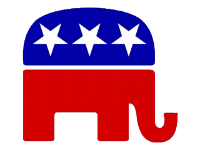Upper Midwestern Republicans Reach Five-Decade High in State House Seats
After the 2010 election, GOP holds 311 of 497 lower chamber seats in IA, MN, ND, SD, and WI (62.2 percent) – the highest level since 1968 election (68.0 percent)

A Smart Politics study of Upper Midwestern historical election returns finds the 311 to 184 seat margin held by Republicans over Democrats when legislative sessions convene in January 2011 to be the largest enjoyed by either party since the Election of 1968.
In 2011, Republicans will hold 62.6 percent of the 497 House seats across Iowa, Minnesota, North Dakota, South Dakota, and Wisconsin.
This level of partisan dominance has not been seen by either party since the 1968 election, when Republicans held 68.0 percent of Upper Midwestern lower chamber legislative seats (362 of 532).
Democrats, meanwhile, have never reached the 60 percent mark during this 40+-year span, coming closest after the Election of 1976, when they controlled 301 of 503 House seats (59.8 percent).
Upper Midwestern Republicans amassed this formidable number of seats last month by setting record or near record highs over the past four to five decades in each state across the region:
· In Wisconsin, the GOP’s 60-seat tally in Assembly races is tied for the highest number of districts won by Republicans in the Badger State since 1958. (Republicans also won 60 seats in 2004). Wisconsin Republicans have now controlled the Assembly for eight of the last nine cycles after a 24-year run by the Democrats from 1971-1994.
· In Iowa, the GOP reached 60 seats for just the second time in the last 38 years (1994, 64 seats), picking up 16 seats to regain control of the lower chamber.
· In Minnesota, the 72 seats won by Republicans is the second highest level recorded by the political right in the Gopher State in 40 years (2002, 82 seats), picking up 25 seats along the way. (Prior to 1974, legislative ballots were cast for ‘liberals’ and ‘conservatives’).
· In North Dakota, the 69-seat GOP tally is the fourth largest percentage of seats held by the Party since 1970 (73.4 percent), behind only 1994 (76.5 percent), 1972 (74.5 percent), and 1996 (73.5 percent). (The number of seats in the North Dakota House has changed periodically over the past several decades).
· In South Dakota, Republicans reached the 50-seat mark for the seventh time since 1970. Republicans have won 50 or 51 seats for five of the last seven election cycles in the Mount Rushmore State.
The GOP sweep across each of the five Upper Midwestern Houses in November is a return to form for the Republicans, after briefly losing stride during the last two election cycles.
Since the 1960 election, there have been seven election cycles in which Republicans held all five lower legislative chambers in the region. Five of these have occurred during the last seven election cycles: 1998, 2000, 2002, 2004, and 2010.
The other two election cycles with Republican sweeps took place in 1962 and 1968.
Democrats have not swept the region dating back through at least 1934.
Overall, Republicans have held more Upper Midwestern seats than Democrats for 20 of the last 28 cycles dating back to the Election of 1956, including nine out of 10 cycles since 1992.
The surge in Republican seats in the region is quite timely for the GOP, as it is one key piece to the redistricting puzzles that will be put together in the coming months (with the exception of Iowa, in which nonpartisan legislative staff propose the new maps).
Partisan Split in Upper Midwestern Lower Legislative Chambers After General Elections, 1960-2010
|
Election
|
GOP
|
Dem
|
3rd
|
% GOP
|
% Dem
|
|
2010
|
311
|
184
|
2
|
62.6
|
37.0
|
|
2008
|
240
|
250
|
1
|
48.9
|
50.9
|
|
2006
|
258
|
239
|
0
|
51.9
|
48.1
|
|
2004
|
297
|
200
|
0
|
59.8
|
40.2
|
|
2002
|
309
|
188
|
0
|
62.2
|
37.8
|
|
2000
|
302
|
199
|
0
|
60.3
|
39.7
|
|
1998
|
297
|
204
|
0
|
59.3
|
40.7
|
|
1996
|
290
|
211
|
0
|
57.9
|
42.1
|
|
1994
|
299
|
202
|
0
|
59.7
|
40.3
|
|
1992
|
251
|
2250
|
0
|
50.1
|
49.9
|
|
1990
|
243
|
266
|
0
|
47.7
|
52.3
|
|
1988
|
242
|
267
|
0
|
47.5
|
52.5
|
|
1986
|
247
|
262
|
0
|
48.5
|
51.5
|
|
1984
|
278
|
231
|
0
|
54.6
|
45.4
|
|
1982
|
242
|
267
|
0
|
47.5
|
52.5
|
|
1980
|
283
|
219
|
0
|
56.4
|
43.6
|
|
1978
|
281
|
222
|
0
|
55.9
|
44.1
|
|
1976
|
202
|
301
|
0
|
40.2
|
59.8
|
|
1974
|
204
|
301
|
0
|
40.4
|
59.6
|
|
1972
|
261
|
244
|
0
|
51.7
|
48.3
|
|
1970
|
270
|
237
|
1
|
53.1
|
46.7
|
|
1968
|
362
|
170
|
0
|
68.0
|
32.0
|
|
1966
|
382
|
150
|
0
|
71.8
|
28.2
|
|
1964
|
238
|
304
|
0
|
43.9
|
56.1
|
|
1962
|
340
|
189
|
0
|
64.3
|
35.7
|
|
1960
|
319
|
206
|
0
|
60.8
|
39.2
|
Note: Compiles seat tallies for Iowa, Minnesota, North Dakota, South Dakota, and Wisconsin. Prior to 1974, Minnesota legislators elected under ‘liberal’ and ‘conservative’ labels. Data compiled by Smart Politics.
Follow Smart Politics on Twitter.
